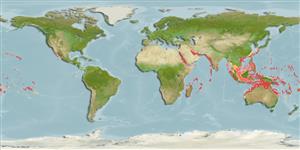Common names from other countries
>
Eupercaria/misc (Various families in series Eupercaria) >
Labridae (Wrasses) > Bodianinae
Etymology: Bodianus: Bodianus after Bodiano or Pudiano, from the Portuguese pudor, meaning modesty (Jordan & Evermann, 1896).; anthioides: Name from the Greek masculine noun 'anthias', a common name for members of the anthiine serranid fishes, and 'oides' for having the form of, refers to the similarity of this species to various anthiine species (Ref. 75973).
More on author: Bennett.
Environment: milieu / climate zone / depth range / distribution range
Ecologia
marinhas associadas(os) a recifes; intervalo de profundidade 6 - 80 m (Ref. 1602), usually 6 - 60 m (Ref. 27115). Tropical; 23°C - 27°C (Ref. 27115); 32°N - 28°S
Indo-Pacific: Red Sea to South Africa (Ref. 35918) and east to the Line and Tuamoto islands, north to southern Japan, south to New Caledonia and the Austral Islands.
Tamanho / Peso / Idade
Maturity: Lm ? range ? - ? cm
Max length : 24.0 cm SL macho/indeterminado; (Ref. 1602)
Espinhos dorsais (total) : 12; Raios dorsais (total) : 9 - 10; Espinhos anais: 3; Raios anais : 10 - 12. Undergoes relatively minor changes in color with growth. Easily identified by the unusual coloration and long tail (Ref. 48636).
Adults inhabit seaward reefs. They occur on reefs rich with invertebrates such as gorgonians, seawhips and black corals (Ref. 48636). Common along steep outer reef slopes deeper than 25 m in Micronesia. Usually seen as lone individuals (Ref. 48636). Juveniles pose as cleaners (Ref. 8631). May be solitary or may exist in pairs (Ref. 5503). Oviparous, distinct pairing during breeding (Ref. 205). Maximum depth reported taken from Ref. 128797.
Ciclo de vida ou comportamento de acasalamento
Maturities | Reprodução | Spawnings | Egg(s) | Fecundities | Larvas
Oviparous, distinct pairing during breeding (Ref. 205).
Gomon, M.F., 2006. A revision of the labrid fish genus Bodianus with descriptions of eight new species. Rec. Aust. Mus. Suppl. 30:1-133. (Ref. 75973)
Status na Lista Vermelha da UICN (Ref. 130435)
CITES (Ref. 128078)
Not Evaluated
Ameaça para os humanos
Harmless
Uso pelos humanos
Pescarias: espécies comerciais; Aquário: Espécies comerciais
Ferramentas
Relatórios especiais
Baixar XML
Fontes da internet
Estimates based on models
Preferred temperature (Ref.
115969): 24.4 - 28.9, mean 27.6 (based on 1138 cells).
Índice de diversidade filogenética (Ref.
82804): PD
50 = 0.5000 [Uniqueness, from 0.5 = low to 2.0 = high].
Bayesian length-weight: a=0.01202 (0.00551 - 0.02625), b=3.05 (2.87 - 3.23), in cm Total Length, based on LWR estimates for this Genus-body shape (Ref.
93245).
Nível Trófico (Ref.
69278): 3.4 ±0.44 se; based on food items.
Resiliência (Ref.
120179): médio(a), tempo mínimo de duplicação da população 1,4 - 4,4 anos (Preliminary K or Fecundity.).
Fishing Vulnerability (Ref.
59153): Low vulnerability (19 of 100).
